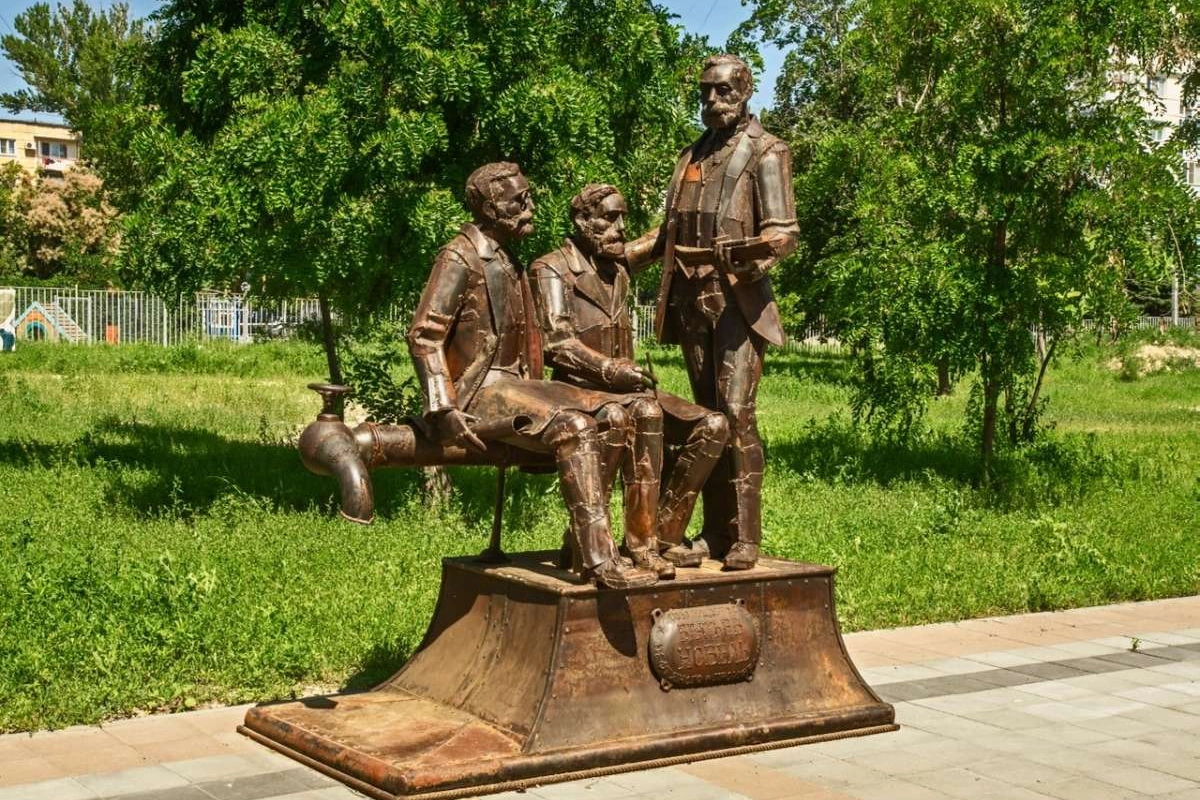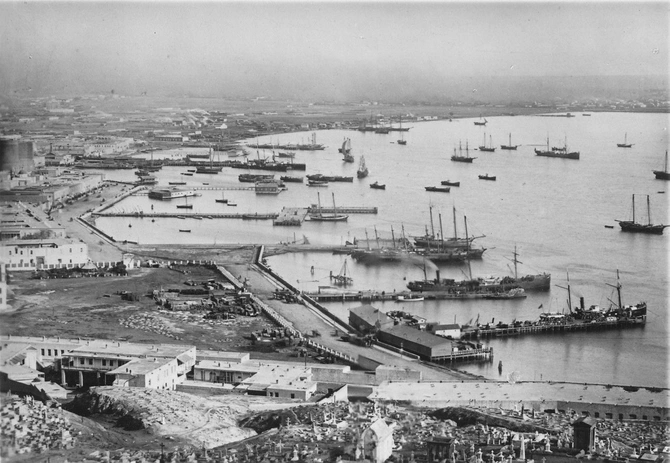
The Nobel Prize is just one of many legacies of a Swedish family whose investments and remarkable new innovations helped transform Azerbaijan’s oil production from the 1870s, helping Baku to be one of the world’s main petro-cities by 1905.
A monument to the Nobel brothers in Central Park in Volgograd, Russia. Image: Shevchenko Andrey/Shutterstock
In Azerbaijan’s oil-rich capital Baku, one of the biggest and busiest east-west thoroughfares is named Nobel Prospekt. The street name pays homage to the Nobel brothers, of whom the best-known today is Alfred Nobel, more often than not remembered for funding the world-renowned Nobel international prize awards. But Alfred was just part of “one of Europe’s greatest entrepreneurial families.” Despite Swedish roots, the Nobels particularly revolutionized aspects of the Imperial Russian economy in the later 19th century, not least in Azerbaijan. There they formed a dynamic oil company that would help Baku to become one of the wealthiest cities on earth –before the Russian revolutions caused a meltdown.

The city of Baku near the turn of the century. Image: Karl Wilhelm Hagelin/Wikimedia Commons
Over the last three decades of the 19th century, Baku was transformed from a minor backwater to the production centre of almost half of the world’s oil supply. Crude oil was a commodity that had suddenly become important. It was not initially used to make gasoline, which only started to gain a market in the 1880s with the development of the motor car, but kerosene. A new process had been developed in the 1850s, allowing the distillation of crude into kerosene (aka paraffin), a commodity in great demand for illumination. So, crude oil was valuable, and the race was on to produce as much as possible for a seemingly insatiable demand. While many Azerbaijani ‘oil baron’ entrepreneurs also played significant roles, the Nobels were lynchpins in Baku’s meteoric rise to world oil capital, introducing tanker ships, pipelines and other critical technical innovations that would prove pivotal. They also developed aggressive business practices that ensured they dictated terms among other local suppliers.
The Nobels’ story starts a generation earlier with the brothers’ father, Immanuel Nobel. An ever-inventive engineer, Immanuel patented several promising new agricultural mechanisms only to find that problems with their commercialization left him bankrupt. He rescued his finances by moving to St Petersburg in 1838, along with his wife Andriette and his surviving children[1]. He developed a new way of making wheel-hubs, carriage wheels and steam engines for warships. Working with his sons, his company also created floating anti-ship mines, the ‘infernal machines’ on which the British navy placed much of the blame for being unable to take the Russian base at Kronstadt in 1854-5 during the Crimean War. When that war ended, however, defeated Russia no longer had the budget to pay for Nobel’s projects and once again, bankruptcy loomed.
Immanuel and, later, his sons, Alfred and Emil (1843-1864), returned to Stockholm, where they began experimenting with explosive mixtures to improve mining technology. That would result in Emil’s tragic death during an unplanned explosion. But it created great wealth for Alfred. Indeed, it is often thought to be Alfred’s sense of retrospective guilt at having invented dynamite that led him to found the Nobel prizes to salve his conscience.
12% of the funds for the original Nobel Prizes are believed to have come from Alfred’s shares in his brothers’ oil company in Baku.
However, it was initially the other brothers who ‘discovered’ Baku. Ludwig and Robert had remained in St Petersburg, re-establishing their father’s Russian arms business, notably with a gun factory at Izhevsk. It was to seek high-quality walnut wood for the company’s rifle butts that, in 1873, Robert first headed south to Azerbaijan. The foothill forests were renowned for their quality timbers, but in the end, it was not wood that caught Robert’s eye but oil. By pure luck, he had found himself in Baku at a perfect moment. Although ‘black naphtha’ had been known in Azerbaijan for centuries, petroleum had only started to become commercially significant. And while Baku’s first oil well was sunk in 1846, investors were only seriously attracted to Azerbaijan following new laws of 1872 and 1876 that freed up the new oil industry first by removing previous ownership restrictions and then by abolishing most excise taxes on oil products.
Now famous for having devised the Periodic Table, Russian chemist Dmitri Mendeleev became a prominent advocate for the liberalization of the Russian oil industry following his travels around the oil districts of Pennsylvania in the 1860s. Mendeleev was also an early supporter of the idea of oil pipelines that the Nobels would employ. However, from the 1880s, when Branobel appeared to be getting close to becoming a monopolistic player in Russia’s oil industry, Mendeleev started a bitter personal feud with Ludwig Nobel. Some have suggested the situation was why, on three occasions, his nomination for a Nobel Prize came to nothing 20 years later.
By 1874 Robert had spent the family’s “walnut money” on a small refinery and a plot of land in Baku. It quickly became apparent that there were enormous sums of money to be made, but that huge investments were needed to make the most of the opportunity. Ludvig and Alfred stumped up further funds and, in 1879, to gain access to shareholder capital formed the limited company Branobel (‘bra’ coming from the first letters of the word “brothers” in Russian). The company not only developed its own oil production and refining, it also set up plants for copper smelting, producing cast iron and making sulphuric acid. The Nobels worked with fellow investors, including the Rothchilds and Marcus Samuel, founder of Shell, to build a railway [and later a pipeline] to Batumi, Georgia, to allow export via the Black Sea to Europe.
The Nobels also commissioned the world’s first oil tanker, a revolutionary steel-hulled ship called Zoroaster built in Sweden in 1878 and sailed to Baku via the Volga and Don Rivers. Eventually, the company would order over 50 such vessels, similarly named for religious figures and philosophers. Many were so big that they had to be shipped to the Caspian in sections and reassembled there. The fleet not only delivered oil but, on return journeys, the Nobels demanded that the tankers bring back fertile soil. Until then, the city of Baku had been predominantly desert, and Alfred Nobel had reportedly said that he never wanted to visit the oil fields there as their sight was particularly depressing. However, to ameliorate the dystopian scene and improve living conditions for at least some of the company’s workers, the Nobels’ efforts created numerous parks and a garden estate of around 20 acres to house key employees close to the refineries of the surrounding oil district. Contrary to other major entrepreneurs of the day who preferred the city lights of central Baku, the Nobels themselves also lived amid the oilfields at the heart of their estate in a splendid mansion known as Villa Petrolea. The building was remarkable for having had an early form of ‘air conditioning’ using 800 tonnes of ice.
Ludvig, who had become Branobel’s chairman, died in 1888 while visiting Cannes (France). A Ludvig Nobel Prize was established in St Petersburg to honour him, funded by money from the Baku company. Awarded by a jury of independent experts under the auspices of the Imperial Russian Technical Society, the prize was designed to honour scientific achievements that had practical applications within the oil industry. It’s widely assumed that this model was later what inspired Ludvig’s brother Alfred to create the bigger (and better funded) Nobel Prize that the world knows today. Alfred was also spurred to consider his legacy, having read an obituary of himself by a newspaper which erroneously believed that it was he, Albert, who had died in France rather than Ludvig.
After Ludvig’s death, the Baku business was run by his 28-year-old son, Emanuel, who proved remarkably successful in his own right. While he failed to establish a monopoly over the whole of the Baku oil supply, thanks to the concerted resistance of a consortium of local producers, Branobel continued to prosper. In 1917 it was Azerbaijan’s dominant oil company by 1917 with over 20 subsidiaries and a capital value estimated at 130 million roubles, 36 million more than its nearest competitor.
However, all would change the following year when Baku fell to the Bolsheviks. The Nobels had been comparatively generous employers compared to many other outfits, and it’s said that Emanuel believed that his “workers were too well paid to opt for revolution.” Thus, while other international investors sold up and fled, Emanuel stayed on – at least at first, hoping to maintain control of the family’s industrial enterprises both in Baku and St Petersburg (then renamed Petrograd). Emanuel attempted to fight the takeovers in the courts and even made a personal appeal to Lenin, but all to no avail and all his businesses were expropriated. However, while other rich industrialists who stayed on found themselves arrested or worse, Nobel and his chief manager were at least spared physical violence by the Bolsheviks, reportedly thanks to the intervention of the company workers who vouched for their relatively good treatment. The Bolsheviks were later kicked out, and Azerbaijan became an independent democratic republic for two years. Still, by then, Emanuel Nobel had little reason to stay, owning little more than his house, the Villa Petrolea. In 1919 he decided to return to Sweden – an odyssey of a journey in which he reputedly travelled across the Caucasus mountains and revolutionary Russia, entering Germany dressed as a merchant woman.
Today the Nobel’s Villa Petrolea house has been restored/rebuilt as faithfully as possible to the original based on photos and documents of the day. It opened in 2008, hosting a Nobel Museum plus an exclusive gentlemen’s club complete with rare artworks. The area of the city that was long known as “Black Town” for all the refineries and oil workings, in the last few years has been undergoing radical gentrification in Haussmann-Parisian style as an upmarket residential zone and renamed with all due irony, “White City.”

[1] Andriette gave birth to either six or eight children according to different sources, of whom only four survived beyond babyhood.
Share on social media